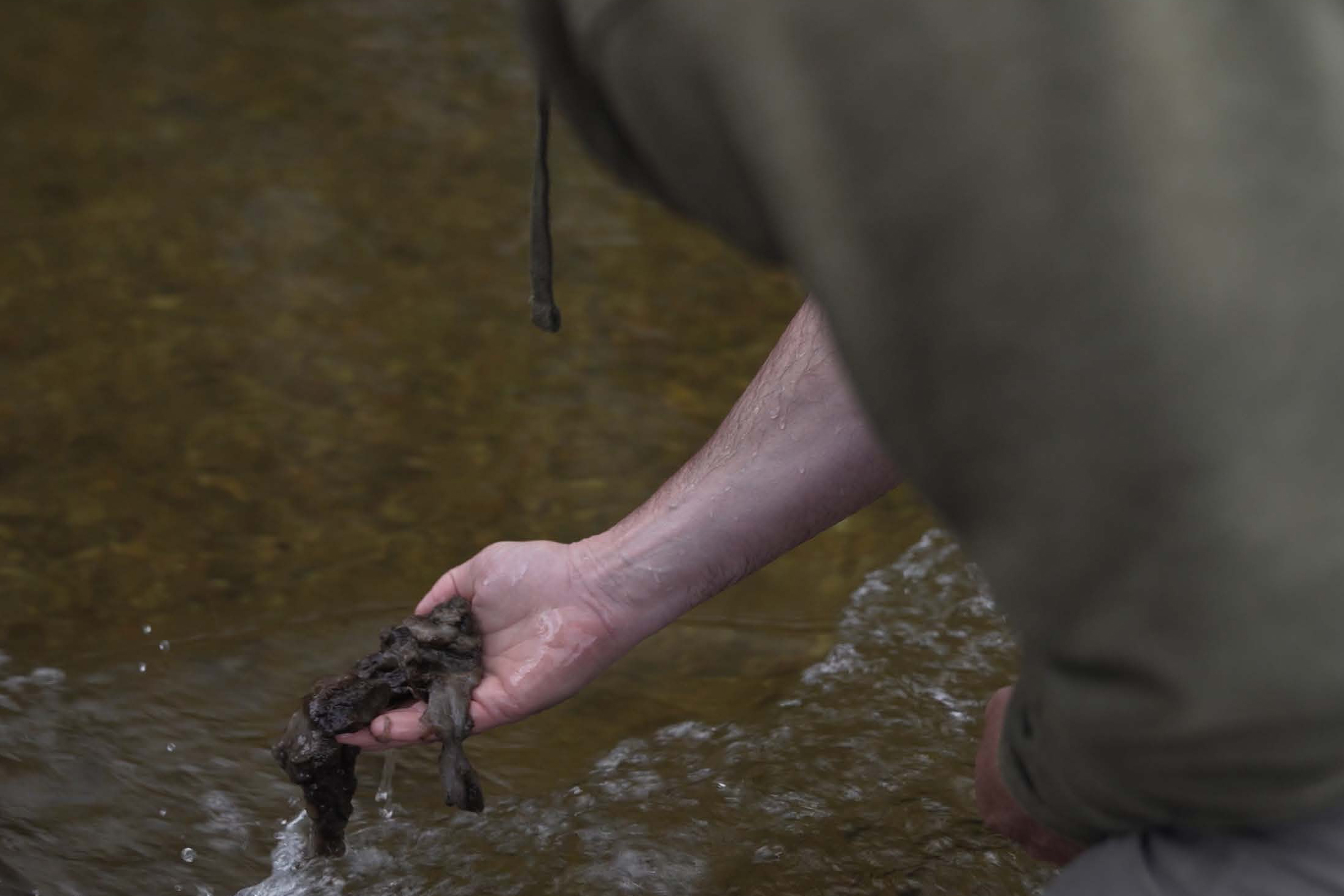Thick ‘rock snot’ continues to be found in Michigan rivers
Didymo, a nuisance alga known as rock snot, could be trouble for the treasured trout fishery in the Upper Manistee River.

Anglers and paddlers are noticing a new phenomenon on the Upper Manistee River—a thick, brown snotty looking algae is clinging to rocks, downed trees, and anything else under the water. Didymo (Didymosphenia geminata), more often referred to as ‘rock snot’ due to its unappealing appearance, was reported in the Upper Manistee River last fall and it continues to plague popular fishing locations on the river. While non-toxic, didymo covers streambeds and reduces habitat for macroinvertebrates, an important food for fish such as trout.
Didymo is microscopic but under the right conditions it can “bloom,” forming dense mats of extracellular stalks giving it a snot-like appearance and making it visible in streambeds. Despite its name, it’s not actually slimy but instead feels like wet wool. Mats can be over six inches thick, making fishing, boating, and swimming unpleasant. In addition, didymo mats trap sediments and can have potentially long-lasting effects on the food chain as they smother other plants, insects and mollusks.
Didymo is native to the northern regions of Europe, Asia and North America and is likely native to Lake Superior and parts of Canada, according to Michigan’s Invasive Species Program. While didymo cells have been documented in the Great Lakes Basin and Michigan waters in low abundance, nuisance blooms are a recent issue and first appeared in the St. Marys River in 2015. Didymo tends to grow in clear, shallow, moderately flowing freshwater streams with rocky substrate. Researchers are still working to determine what triggers didymo’s nuisance blooms.

Didymo blooms have generally increased across the United States. Scientists believe this may be partly due to changing environmental conditions. Didymo may also be spreading to new waterways on fishing gear, a common method in which nuisance species spread. Research has shown didymo can survive for 40 days in cool, dark, damp conditions such as on angling equipment, neoprene and felt-soled waders, and boots.
“Right now, didymo is a big puzzle with a lot of people working to address it. We need to find out why it’s showing up where it is and more importantly, how best to decontaminate gear to prevent it from spreading,” said Ann Miller, an aquatic biologist and avid Manistee River flyfisher. “Right now, many local fishing guides are doing their best to avoid the stretch of the Manistee where didymo is blooming but fishing is their livelihood.”
What can you do to help?
There is no effective method to eradicate didymo from the environment. To prevent spreading it and other nuisance species, it is critical for recreational users to decontaminate their equipment after leaving a waterway. Decontamination includes cleaning, draining and drying everything that has entered the water, including boats, anchors and anchor lines, trailers, boots, waders, nets and other equipment.
Decontamination steps when moving any gear from one waterbody to another should include the following:
- Clean all mud, debris and aquatic plant material from equipment such as boats, trailers, waders, hip boots, dip nets and other field gear. Didymo, like many nuisance and invasive species, is not always visible so wiping down equipment is beneficial, even if you cannot see it. For didymo, a study has shown that soaking equipment for one minute in hot water or a chemical disinfectant such as bleach (diluted to 2% strength) or soapy water (5% solution) is an effective cleaning technique.
- Drain live wells, bilges, bait buckets and any other water from equipment before leaving the access site.
- Dry your gear and watercraft for at least five days, if possible, before going to a new waterbody.
Other tips to consider when fishing in waterways known to have didymo:
- Plan time to decontaminate between trips.
- Avoid hopping between multiple rivers in a single day.
- Designate specific gear, especially porous items like felt soled waders and anchor rope, for use only in infested waters.
Visit Michigan State University Extension’s Michigan Clean Boats, Clean Waters program for more information on preventing the spread of aquatic invasive species on boating and fishing equipment.

Report didymo sightings
In addition to cleaning gear, one of the most important steps you can take is to report observations of didymo and any other suspected invasive species to conservation organizations. You can report to the Midwest Invasive Species Information Network (MISIN), a regional database used by invasive species specialists predominantly in Michigan and the Midwest. After creating an account, you can report your observation and biologists will be notified. Additionally, didymo can be reported by emailing the location and photos to EGLE-WRD-AIP@Michigan.gov. The United States Geological Survey also maintains a Nonindigenous Aquatic Species database that accepts reports from the public.
Learn more about didymo
Michigan’s Invasive Species Program will be hosting a NotMISpecies webinar on June 9, from 9 - 10 a.m. on didymo ecology, potential impacts and current research. The presentation will be given by Dr. Ashley Moerke of Lake Superior State University and staff from the Michigan Department of Natural Resources and the Michigan Department of Environment, Great Lakes and Energy (EGLE). The May NotMISpecies webinar featured a presentation on watercraft decontamination essentials to prevent the spread of invasive species by Kelsey Bockelman from MSU Extension and Kevin Walters from EGLE. NotMISpecies webinars are conducted monthly, and registration and recordings are available on the NotMISpecies webinar website.



 Print
Print Email
Email

